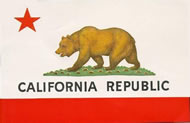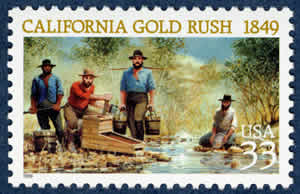The Bear Flag Republic
Look at the coast of California and what do you see: San Diego, Los Angeles, Santa Barbara, San Jose, Monterrey, San Francisco and so on. You can tell a lot about California's history just from looking at the names of its major cities. Like Texas, California also evokes certain images among the American people: Hollywood, movies, the San Andreas fault, death Valley, the beautiful beaches had high mountains. Will it was an area to be coveted by anyone who had seen it, and President Polk coveted California from the moment he took office. His desire for California contributed to the causes of the Mexican-American war.
 The Spaniards were not the only people interested in the California coast. If You drive northward out of San Francisco along Highway 101 and onto California Route 1 for about 85 miles, you will come to Fort Ross State Historic Park, the site of a Russian Fort built in the early 1800s. A product of European imperial ventures, Fort Ross was the result of Russian expansion from Siberia across the Bering Strait to Alaska and from there down the west coast of North America. The settlement of Fort Ross (from the Russian poetic word, Ros, for Russia) occurred in 1812, and it was an active Russian trading site for decades.
The Spaniards were not the only people interested in the California coast. If You drive northward out of San Francisco along Highway 101 and onto California Route 1 for about 85 miles, you will come to Fort Ross State Historic Park, the site of a Russian Fort built in the early 1800s. A product of European imperial ventures, Fort Ross was the result of Russian expansion from Siberia across the Bering Strait to Alaska and from there down the west coast of North America. The settlement of Fort Ross (from the Russian poetic word, Ros, for Russia) occurred in 1812, and it was an active Russian trading site for decades.
The first Europeans to explore California were the Portuguese, but they did not create permanent settlements. The first Spanish explorer arrived in southern California in 1542. Later in the 1500s the Spaniards used California as a stopping point in their trade with the Far East. Sir Francis Drake also explored California, but the British never established settlements on the west coast of North America. Spanish interest in California continued through the 1600s, and beginning in the late 1700s, teh Spaniards began building a series of missions throughout Calfornia, Colonization proceeded slowly, however, as southwestern Indian tribes repeatedly blocked land routes from Mexico to California.
When Mexico became independent from Spain in 1821, California become one of the provinces of the Mexican Empire, with the capital at Monterrey, about 120 miles south of San Francisco. The province was only sparsely settled, however, with a population of fewer than 10,000 by the mid 1840s. One early community was Fort Sutter, created by Swiss immigrant John Sutter; it was populated laregly by new immigrants from the United States and fortified with armaments bought from the Russian Fort Ross when the Russians departed.
With American interest in both Oregon and California heating up, President Polk, elected on a policy consistent with the idea of manifest destiny, became interested in acquiring California. Mexico, meanwhile, still angry over the annexation of Texas, refused to negotiate with an American envoy sent by Polk on the sale of California. When war broke out with Mexico, several U.S. Navy warships and U.S. Marines were in California overseeing American interests there. An army mapping expedition under Captain John C. Frémont was also in California. Additional ships were sent as the war progressed, and a revolt against Mexican rule was eventually carried out with the cooperation of American forces under Commodore John Sloat. An independent California "Bear Flag Republic" was proclaimed in the area north of San Francisco. A week later Frémont assumed authority over the area on behalf of the United States. Later in 1846 additional naval forces under Commodore Robert Stockton arrived from Hawaii and joined with Frémont. The combined forces occupied much of the remaining territory of California.
 By 1847 hundreds of additional American troops had arrived in California, some by sea, some ahving come overland, and all of California was under American control. California was annexed in 1848 and paid for under the terms of the Treaty of Guadalupe Hidalgo. Until 1850, the California territory was run my military governors. As the population swelled, military governor General Bennett C. Riley called for a Constitutional Convention for California. The territory was ready to become a state.
By 1847 hundreds of additional American troops had arrived in California, some by sea, some ahving come overland, and all of California was under American control. California was annexed in 1848 and paid for under the terms of the Treaty of Guadalupe Hidalgo. Until 1850, the California territory was run my military governors. As the population swelled, military governor General Bennett C. Riley called for a Constitutional Convention for California. The territory was ready to become a state.
The California Gold Rush
When gold was discovered at Sutter’s Mill in 1848, thousands of Americans began flocking to California’s gold fields in 1849, creating demand for a territorial government. There were few slaves in California, though more than in New Mexico and Utah combined. Although California passed “sojourner” laws that allowed slaveholders to bring slaves and keep them for a time, slavery was not an admission issue. With slavery recognized and protected in the Constitution, the issue of slavery in states where it already existed was, for all but staunch abolitionists, not a serious issue. The issue of slavery in territories not yet states was a very big issue, however. When Californians submitted an antislavery constitution with their request for admission, Southerners were outraged because the admission of California would give the free states majority control of the Senate.